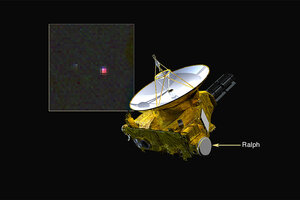NASA zeroes in on Pluto, detects frozen methane
As NASA's New Horizons makes final preparations to zoom past Pluto, the probe continues to make startling observations.

The location of the New Horizons Ralph instrument, which detected methane on Pluto, is shown. The inset is a false color image of Pluto and Charon in infrared light; pink indicates methane on Pluto’s surface.
NASA/Johns Hopkins Applied Physics Laboratory/Southwest Research Institute
As NASA’s New Horizons spacecraft closed in on Pluto’s surface, two weeks before its rendezvous with the ex-planet, it detected a substance scientists had long suspected was there: frozen methane.
Astronomers in California had first observed the chemical compound on Pluto in 1976.
But Will Grundy, the New Horizons Surface Composition team leader with the Lowell Observatory, said Tuesday’s detection was the first confirmation of their observations. “Soon we will know if there are differences in the presence of methane ice from one part of Pluto to another,” he said in a statement.
NASA said Pluto’s methane may have always been there, “inherited from the solar nebula from which the solar system formed 4.5 billion years ago.”
The New Horizons spaceship will whiz past Pluto on July 14 “in a flyby that will give humanity its first up-close look at Pluto and its moons,” The Christian Science Monitor's Pete Spotts wrote in April.
So many questions surround the system that it presents “a scientific wonderland,” Alan Stern, lead scientist for the mission, told the Monitor.
Satellite photographs from the $700 million mission have already offered extraordinary glimpses at the dwarf planet that scientists speculate is even redder than Mars, with rivers of liquid neon flowing across the surface and a subsurface liquid-water ocean.
The latest image of Pluto and its largest moon, Charon, shows only two icy gray circles to the undiscriminating eye, but scientists have already detected new details.
“Pluto and Charon are becoming more distinct in their surface features,” Alice Bowman, the missions operations manager for New Horizons, said Tuesday in a mission update.
To ensure each instrument is in position for the historic encounter on the 14th, the spacecraft is undergoing final, minute adjustments, said mission design lead Yanping Guo of the Johns Hopkins Applied Physics Laboratory. Tuesday's 23-second thruster burn kept New Horizons from arriving 20 seconds late and 114 miles off-target.
In addition, obstacles like icy debris are dealt with en route, NASA said.
"Our team has worked hard to get to this point, and we know we have just one shot to make this work," said Ms. Bowman in April. "We’ve plotted out each step of the Pluto encounter, practiced it over and over, and we’re excited the ‘real deal’ is finally here."

